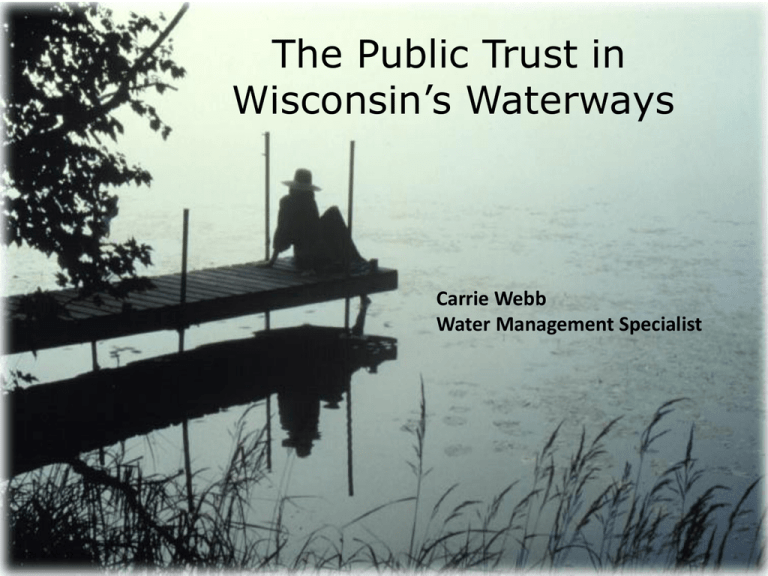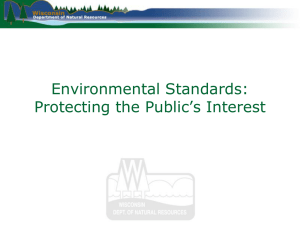The Public Trust in Wisconsin’s Waterways Carrie Webb Water Management Specialist
advertisement

The Public Trust in Wisconsin’s Waterways Carrie Webb Water Management Specialist Protected Public Interests: • • • • • • • Commercial Navigation Boating and Recreation Fishing Hunting Natural Scenic Beauty Fish and Wildlife Habitat Water Quality and Quantity Typical projects that require permits Shoreline & Streambank Erosion Control Boat Shelters Boathouses Bridges/Culverts Ponds/Artificial Waterways Structures Dredging Work in wetlands Permit Process • Exemptions • General Permits • Individual Permits Exemptions - What They Are… • EXEMPT activities do not require a permit nor do they require notification to the Department. • They are NOT unregulated activities. Exemptions—The Process 1. Is an exemption available? 2. Is the project located in a designated water? 3. Does the project meet the exemption standards? 4. Proceed with the project or submit an Exemption Determination Request (EDR) General Permits—What They Are • Permits for activities that meet specific standards and are located in specific areas. • Must meet specific design, location & construction standards (Eligibility Criteria) General Permits—Availability • Available for most activities in most areas • Some are not available in Areas of Special Natural Resource Interest or public rights features. Individual Permits—What They Are • Permits for activities that are more complex that do not meet the exemption or general permit standards. • Individual Permits are available in all areas however some activities may be prohibited by statute or rule. Individual Permits—The Process 1. A preliminary decision is made, then a public notice is issued. 2. The public has 30 days to comment and 20 days to request an informational hearing. 3. If a hearing is requested, applicant will need to publish the notice of hearing. 4. An informational hearing is held. 5. A permit decision is issued after the hearing and notice period. Lakeshore vs. Streambank • Different Standards & Eligibility Criteria - NR 328 Subchapter I – Inland Lakes & Impoundments - NR 328 Subchapter III – Rivers & Streams • Different Application Packets Lakeshore Erosion Control Available General Permits: Biological Riprap/Vegetated Armoring Riprap Repair Riprap Replacement Replace Seawall w/ Riprap Seawall Replacement (Very Limited) Streambank Erosion Control Available General Permits: Biostabilization Vegetative Armoring (Integrated Bank Treatment) Replacement of Structure w/ Biological methods Replacement of Structure w/ Integrated Bank Treatment Repair of Riprap placed prior to Aug. 2007 Biological Erosion Control (Biostabilization) A structure that relies solely on biological materials Constructed of living or organic materials that are biodegradable such as native plants, live stakes, branches, fiber rolls & mats, encapsulated soil lifts etc…. GP Integrated Bank Treatment A structure that combines 2 separate treatments: structural treatment w/ inert materials for toe protection at the base of the bank, and biostabilization on the upper portion of the bank. Riprap Layers of rock including filter material placed on the bed & bank of a navigable waterway. Key Considerations • Communication Complete Applications Planning Early Application Information Requirements • Application form. A complete, signed application form “Water Resources Application for Project Permits (WRAPP)” (Form# 3500-53). • Site maps which clearly illustrate the location and perimeter of the project site, and its relationship to nearby water resources (e.g. lakes, rivers, streams, wetlands), major landmarks and roads. • Photographs that clearly show the existing project area. Remember that too much snow cover or vegetation may obscure important details. If possible, have another person stand near the project area for size reference. • Project plans and specifications reflecting the General Permit Eligibility Standards as listed in the project-specific checklists. • Project Narrative description of work that is proposed, from initial site preparation to installation and final site stabilization, detailing equipment used, erosion control measures, timing, etc. . • Permit fee Pier Planner Exemptions: • Flow through • 6 feet wide with up to a 200 sq. ft. platform • “Reasonable use” • In exclusive riparian zone • To the 3 foot water depth • Does not obstruct navigation • May not harm public interests No requirement to remove every year QUESTIONS? www.dnr.wi.gov/permits/water





